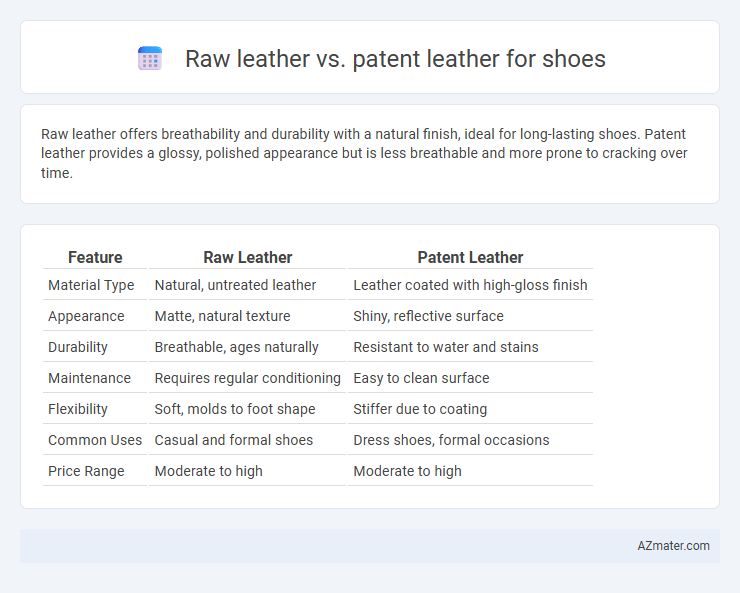Raw leather offers breathability and durability with a natural finish, ideal for long-lasting shoes. Patent leather provides a glossy, polished appearance but is less breathable and more prone to cracking over time.
Table of Comparison
| Feature | Raw Leather | Patent Leather |
|---|---|---|
| Material Type | Natural, untreated leather | Leather coated with high-gloss finish |
| Appearance | Matte, natural texture | Shiny, reflective surface |
| Durability | Breathable, ages naturally | Resistant to water and stains |
| Maintenance | Requires regular conditioning | Easy to clean surface |
| Flexibility | Soft, molds to foot shape | Stiffer due to coating |
| Common Uses | Casual and formal shoes | Dress shoes, formal occasions |
| Price Range | Moderate to high | Moderate to high |
Introduction to Raw and Patent Leather
Raw leather, also known as full-grain leather, retains its natural surface, offering durability, breathability, and a unique texture that ages beautifully over time. Patent leather features a glossy, high-shine finish achieved through a coating process, making it ideal for formal shoes due to its sleek and polished appearance. Choosing between raw and patent leather depends on the desired aesthetic and functional qualities, with raw leather providing ruggedness and patent leather offering elegance.
Understanding Raw Leather: Characteristics and Uses
Raw leather is an untreated, natural hide known for its breathability, durability, and unique texture that develops a patina over time. It is favored in shoe production for its ability to mold to the wearer's foot while offering a matte, rugged aesthetic that contrasts with the shiny, coated surface of patent leather. Commonly used in casual and work footwear, raw leather requires regular maintenance to retain its suppleness and prevent water damage.
What Sets Patent Leather Apart?
Patent leather stands out for its glossy, mirror-like finish achieved through a coating process that makes it highly water-resistant and easy to clean compared to raw leather. Unlike raw leather, which boasts a natural, breathable, and matte surface prone to scuffs and stains, patent leather offers durability with a sleek, polished appearance ideal for formal footwear. The synthetic coating on patent leather also provides a firmer texture, enhancing shoe shape retention and long-term wear resilience.
Appearance: Matte Versus Glossy Finish
Raw leather offers a matte finish characterized by its natural, subdued texture that enhances a rustic and timeless aesthetic. Patent leather is distinguished by its high-gloss, reflective surface achieved through a coating process, providing a polished and formal appearance ideal for dress shoes. The choice between raw leather and patent leather significantly influences the shoe's visual impact, with raw leather appealing to casual styles and patent leather suited for more elegant, dressy occasions.
Durability and Longevity Comparison
Raw leather offers superior durability due to its natural fibers and minimal processing, making shoes resistant to wear and tear over time. Patent leather, coated with a glossy synthetic finish, provides less breathability and can crack or peel under prolonged stress or exposure to moisture. For long-term use, raw leather shoes generally maintain structural integrity better, while patent leather shoes require careful maintenance to preserve their shiny appearance.
Comfort and Breathability in Shoes
Raw leather offers superior comfort and breathability in shoes due to its natural fibers and porous structure, allowing better air circulation and moisture absorption. Patent leather, coated with a glossy synthetic finish, limits airflow and traps heat and moisture, which can reduce overall foot comfort during extended wear. Choosing raw leather ensures enhanced ventilation and a more comfortable fit, especially for prolonged use or warm climates.
Maintenance: Cleaning and Care Requirements
Raw leather shoes require regular brushing and conditioning with leather-specific products to maintain flexibility and prevent drying or cracking, while avoiding excessive water exposure is crucial. Patent leather shoes benefit from simpler maintenance, involving frequent wiping with a damp cloth and occasional polishing to preserve their glossy finish and prevent scuff marks. Both types demand proper storage away from direct sunlight and moisture to extend shoe lifespan and maintain aesthetic quality.
Style Versatility: Occasions and Fashion Trends
Raw leather offers a timeless, matte finish that pairs well with casual and formal outfits, making it ideal for versatile, everyday wear and traditional fashion trends. Patent leather, known for its glossy, reflective surface, suits more polished, evening events and adds a bold statement to contemporary fashion styles. Combining both materials in footwear collections addresses diverse occasion needs, enhancing style adaptability across seasons and trends.
Price and Value Considerations
Raw leather shoes typically offer greater durability and natural breathability at a moderate price point, making them a cost-effective choice for long-term use. Patent leather shoes, known for their glossy finish and formal appearance, often come at a higher price due to the specialized coating process but may require more maintenance to preserve their shine. Consumers prioritizing initial affordability and longevity usually favor raw leather, while those valuing aesthetic appeal and occasional wear might invest more in patent leather options.
Which Leather is Best for You?
Raw leather offers superior breathability and natural durability, making it ideal for those seeking comfort and long-lasting wear in shoes. Patent leather provides a glossy, polished finish that resists water and stains, perfect for formal occasions or stylish footwear requiring low maintenance. Choosing the best leather depends on your lifestyle needs: raw leather suits daily wear and casual use, while patent leather excels in fashion-forward, dressy environments.

Infographic: Raw leather vs Patent leather for Shoe
 azmater.com
azmater.com